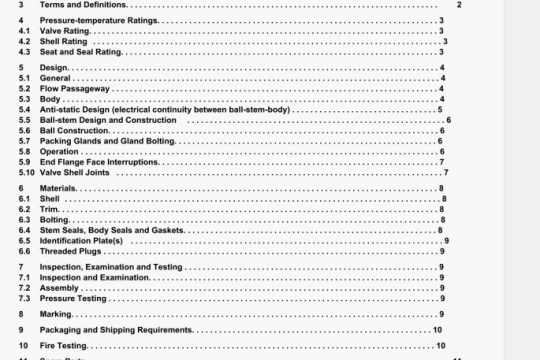API RP 11L:2008 pdf download
API RP 11L:2008 pdf download.Design Calculations for Sucker Rod Pumping Systems (Conventional Units).
2.2 The designer must realize that there are a number of unusual conditions which may be present in a well that
could cause misleading condusions from these design calculations. Some of these unusual conditions are:
a) slanted or crooked holes;
b) very viscous fluid:
C) excessive sand production:
d) excessive gas production through the pump; and
e) well flowing-off.
2.3 The research work was limited to simulated problems in which the tubing was assumed as bewg anchored at the pump. Therefore, the test results reflected only this condition. However, because of the many known cases In which tubing is unanchored. a formula is included which, experience indicates, will give a very close approximation of relative plunger travel with respect to the pump. This value is identified with the symbol Si,. Examination of the formula will reveal that the contraction of the tubing caused by the transfer of the fluid load from the standing vahe to the traveling valve is subtracted from the calculated plunger stroke. It is realized that this formula is highly sinplifled and not mathematically correct, but it is dose enough for practical application.
2.4 These design calculations may be used with confidence when applied to the broad category of average, normal pumping wells fitting the assumed conditions outlined in Annex A. Unusual, conditions not fitting the assumptions will cause deviations from calculated performance. The designer must recognize this fact even though he cannot calculate quantitative values for this deviation.
3 Symbols and Formulas
3.1 Symbols, with Units Where Applicable, Used In the Technical Report
3.1.1
CBE
counterweight requIred. lb
3.1.2
D
plunger diameter. m.
3.1.3
Er
elastic constant—rods, milb-ft (Table 4.1, Column 4).
NOTE E, represents the indies of elongation caused by the application of a load of ii) to a rod 1 ft ii length
3.1.4
elastic constant—tubing, iniib ft (see Table 4.2. Column 5)
NOTE E,representstheindiesofelongationcausedbyapplicatbonofaloadofl Itoasecbonofting 1 ftinlenglh.
3.1.5
F1
PPRL factor (see Figure 3.1)
4.6 Perform the indicated mathematical operations indicated through step 11 (per example Data Sheet ilL). If the tubing is anchored, IA, (step 11) is equal to zero and need not be calculated. The values are now available with which the bottom hole pump stroke, S, and the pump displacement, PD, may be calculated.
4.7 ‘Mth the calculated values of F01S&,. and MNO. record the value o(S(Sfrom figure 4.1 and solve for S1 and POrn steps 13 and 14 (per example Data Sheet ilL). Pump displacement Is the first test being made to see if the prellniinay selection of oorronents for the installation is satisfactory. It the pump displacement calculated in step 14 fails to satisfy known or anticipated requirements, appropnate adjustments must be made in the assumed data and steps 1 through 14 repeated. When the calculated pump displacement is acceptable, proceed with the design calculations by perfOrming steps 15, 16 and 17.
4.8 By using the calculated values of F, iSk, and VIN0, the values of F1ISAr (see Figure 4.2), F ISlc (see Figure 4.3),
271S2. (see Figure 4,4), and F4iS,l (see Figure 4.5) are read from the curves and recorded, When refemng to Figures
4.1 and 4.6 to determine 5,/Sand 7 the value of, must be used. Record the value of T,
4.9 Substitution of the appropiate values in the various formulas and performance of the indicated mathematics in steps 23 through 27 of the example Data Sheet ilL will yield the various loads to be expected from the preliminary selection of equipment. It Is now necessary to compare these calculated loads with limitations imposed by the preliminary selection. Calculate the stress in the sucker rods to determine if it is within acceptable lwnits.
4.10 Generally, more than one selection of equipment and calculation of operating conditions is necessary before the optimum selection can be made.




